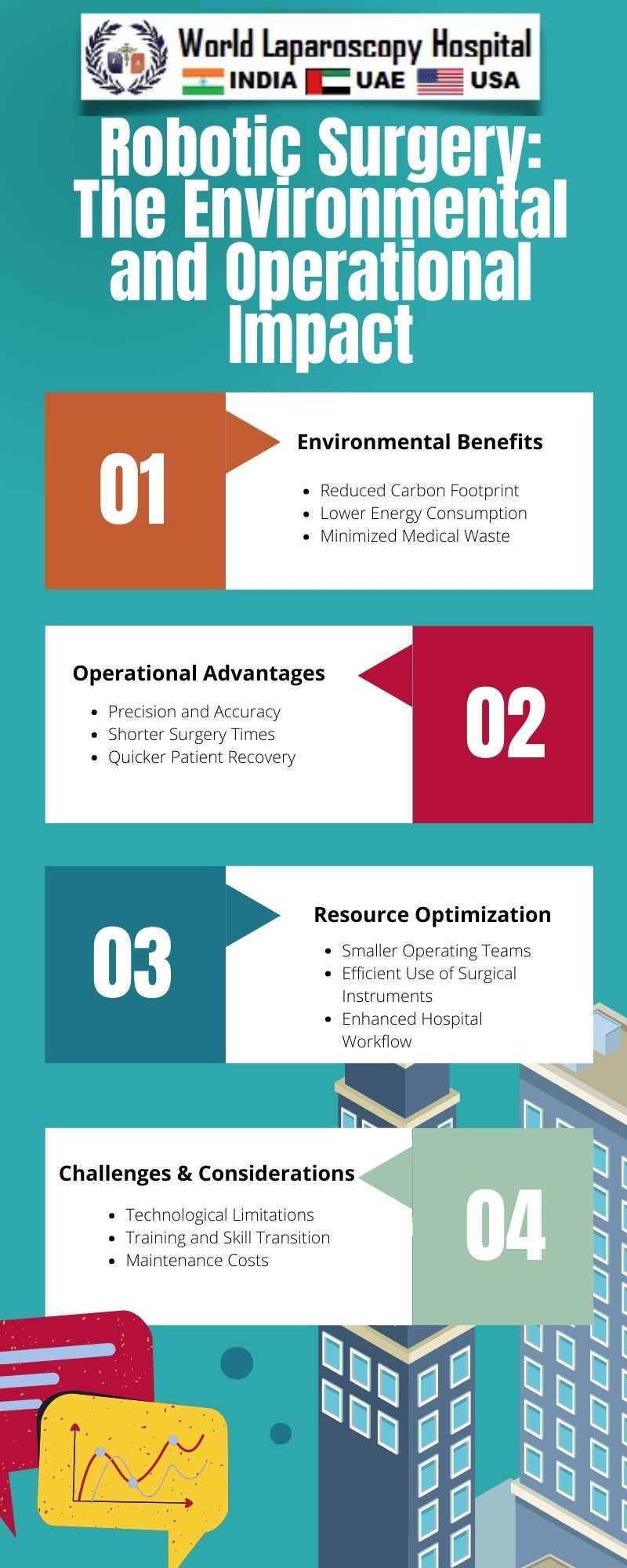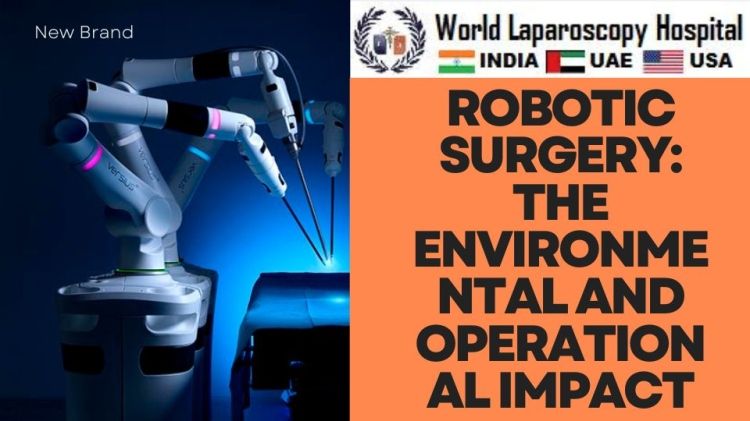Robotic Surgery: The Environmental and Operational Impact
Introduction:
In the realm of modern medicine, robotic surgery stands as a groundbreaking technological advancement, promising enhanced precision and reduced invasiveness. While the clinical benefits of robotic-assisted procedures are well-documented, this article delves into the often-overlooked dimensions of its environmental and operational impact. As robotic surgery becomes increasingly prevalent, understanding and mitigating its ecological footprint is crucial for a sustainable healthcare future.

The Clinical Advancements of Robotic Surgery
Before delving into the environmental and operational aspects, it's essential to acknowledge the clinical advancements that have propelled robotic surgery to the forefront of medical innovation.
Enhanced Precision and Dexterity
Robotic surgical systems, such as the da Vinci Surgical System, offer unparalleled precision and dexterity. Surgeons can manipulate robotic arms with greater accuracy than traditional methods, enabling intricate procedures with minimal trauma to surrounding tissues.
Minimally Invasive Procedures
Robotic surgery facilitates minimally invasive procedures, reducing patients' postoperative pain, hospital stays, and recovery times. Smaller incisions lead to decreased blood loss and a lower risk of infection, contributing to overall improved patient outcomes.
Telepresence and Remote Surgery
The integration of telepresence technology allows experienced surgeons to perform procedures remotely. This capability proves invaluable in scenarios where specialized expertise is geographically distant, expanding access to high-quality surgical care.
The Environmental Impact of Robotic Surgery
While the clinical benefits of robotic surgery are evident, its environmental impact requires careful consideration. The life cycle of robotic systems, from manufacturing to disposal, poses challenges that demand sustainable solutions.
Manufacturing and Resource Consumption
The production of robotic surgical systems involves the extraction and processing of raw materials, contributing to resource depletion and environmental degradation. The intricate components and advanced technologies within these systems necessitate the extraction of rare minerals, often with environmental consequences.
Efforts to address this impact include the exploration of eco-friendly materials, recycling initiatives, and a push towards more energy-efficient manufacturing processes. Balancing the clinical benefits of robotic surgery with responsible material resourcing is a pressing challenge for the industry.
Energy Consumption and Carbon Footprint
Robotic surgical systems require significant energy inputs for both their operation and maintenance. High-tech consoles, robotic arms, and supporting infrastructure demand a substantial power supply, contributing to carbon emissions if sourced from non-renewable energy.
To mitigate this, advancements in energy-efficient technologies, coupled with a shift towards renewable energy sources, are essential. The healthcare industry must prioritize environmentally conscious practices to ensure the widespread adoption of robotic surgery aligns with global sustainability goals.
Waste Management and Disposal
The disposal of robotic systems at the end of their life cycle presents another environmental challenge. Electronic waste (e-waste) from outdated or malfunctioning components poses risks to ecosystems and human health.
Implementing comprehensive e-waste management strategies, including recycling and responsible disposal practices, is imperative. Incorporating modular design principles to facilitate component replacement rather than entire system disposal can minimize environmental impact.
The Operational Impact of Robotic Surgery
Beyond its environmental considerations, robotic surgery significantly influences the operational dynamics of healthcare institutions. From workforce dynamics to financial implications, understanding these aspects is crucial for effective integration.
Workforce Training and Skill Development
The adoption of robotic surgery necessitates specialized training for medical professionals. Surgeons, nurses, and support staff must acquire proficiency in operating and troubleshooting robotic systems. This transition raises questions about the availability of training programs, the time required for skill acquisition, and the potential disparities in access to training resources.
Investing in comprehensive training infrastructure, virtual simulation technologies, and ongoing skill development programs will be key to ensuring a well-prepared healthcare workforce.
Economic Considerations and Cost-Benefit Analysis
While robotic surgery offers clinical advantages, the economic implications cannot be overlooked. The initial costs associated with acquiring and maintaining robotic systems can be substantial, impacting budgetary allocations for healthcare institutions.
Conducting thorough cost-benefit analyses, considering factors such as reduced hospital stays, faster recovery times, and long-term efficiency gains, is essential for informed decision-making. Striking a balance between upfront investment and long-term operational savings will be crucial for the widespread adoption of robotic surgery.
Integration with Existing Healthcare Infrastructure
The seamless integration of robotic surgery into existing healthcare systems poses challenges in terms of infrastructure compatibility and workflow adaptation. Surgical suites, support staff, and patient pathways must be reconfigured to accommodate the unique requirements of robotic procedures.
Collaboration between healthcare providers, technology developers, and facility managers is vital for optimizing the integration process. Customizing existing infrastructure to support robotic surgery while minimizing disruptions to routine medical operations is a complex but necessary undertaking.
Striking a Balance: Toward Sustainable Robotic Surgery
The evolving landscape of robotic surgery demands a holistic approach that addresses its clinical benefits while mitigating its environmental and operational challenges.
Sustainable Technological Innovation
Encouraging sustainable practices within the development and manufacturing of robotic systems is a critical step. Innovations in eco-friendly materials, energy-efficient technologies, and modular designs can significantly reduce the environmental impact of these systems.
Research and development efforts should prioritize the creation of robotic platforms that are not only clinically advanced but also aligned with environmental sustainability goals.
Robust Training Infrastructure
To ensure the seamless integration of robotic surgery into healthcare practices, establishing comprehensive training infrastructure is essential. Virtual simulations, hands-on training programs, and continuous professional development opportunities can equip medical professionals with the skills needed for safe and effective robotic procedures.
Comprehensive Cost-Benefit Analyses
Institutions considering the adoption of robotic surgery must conduct thorough cost-benefit analyses. Evaluating the long-term economic impact, including potential savings from reduced hospital stays and faster recovery times, will guide informed decision-making and contribute to the sustainability of this technology in healthcare.
Collaborative Stakeholder Engagement
Addressing the operational challenges of robotic surgery requires collaborative efforts among stakeholders. Healthcare providers, technology developers, regulatory bodies, and policymakers must work together to create standards, guidelines, and infrastructure that support the integration of robotic surgery into existing healthcare systems.
Conclusion:
Robotic surgery stands at the intersection of technological innovation and healthcare advancement, offering unprecedented clinical benefits. However, its journey towards sustainability involves navigating complex environmental and operational considerations. By prioritizing eco-friendly practices, investing in workforce development, conducting thorough economic analyses, and fostering collaborative engagement, the healthcare industry can ensure that robotic surgery aligns with a vision of a more sustainable and efficient future.






